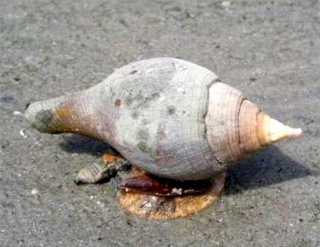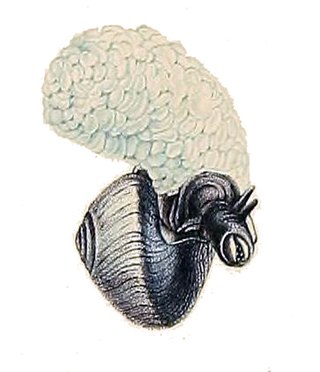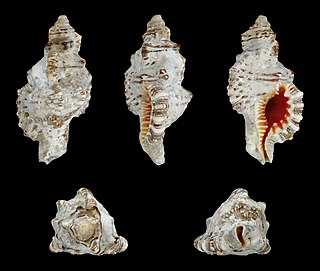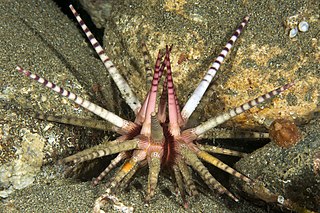
Charonia is a genus of very large sea snail, commonly known as Triton's trumpet or Triton snail. They are marine gastropod mollusks in the monotypic family Charoniidae. They are one of the few natural predators of the crown-of-thorns starfish.

Xenia is a genus of photosynthetic soft marine coral in the family Xeniidae. They resemble a mushroom, with "arms" coming out from the top that ends in many-fingered "hands". It is unique among corals because of its ability to use its "hands" to "pulse" or push water away from the colony in a constant, grabbing motion. Common names include fast-pulse Xenia. Species of Xenia are sometimes referred to as pulse corals.

Arbacia is a genus of sea urchins, widespread in the Atlantic and eastern Pacific oceans.

Turbinella is a genus of very large sea snails with an operculum, marine gastropod mollusks in the subfamily Turbinellinae of the family Turbinellidae.

Janthina is a genus of small to medium-sized pelagic or planktonic sea snails, marine gastropod molluscs in the family Epitoniidae.

Cymatium is a genus of small to large predatory sea snails, marine gastropod mollusks in the family Cymatiidae.

Chicoreus is a genus of medium- to large-sized predatory sea snails. These are carnivorous marine gastropod molluscs in the family Muricidae, the murexes or rock snails.

Fulguropsis is a genus of sea snails, marine gastropod molluscs in the family Busyconidae, the crown conches and their allies.

Perrona is a genus of sea snails, marine gastropod mollusks in the family Clavatulidae.
Azumamorula mutica, common name the smooth ricinula, is a species of sea snail, a marine gastropod mollusk in the family Muricidae, the murex snails or rock snails. It is the only species in genus Azumamorula.
Jaton is a genus of sea snails, marine gastropod mollusks in the subfamily Ocenebrinae of the family Muricidae, and murex snails or rock snails.

Monodonta is a genus of sea snails, marine gastropod mollusks in the family Trochidae, the top snails.

Stomatella is a genus of small to medium-sized sea snails, marine gastropod mollusks in the family Trochidae, the top snails and their allies.

Monoplex is a genus of predatory sea snails, marine gastropod mollusks in the family Cymatiidae.

Ranularia is a genus of predatory sea snails, marine gastropod mollusks in the family Cymatiidae.
Ricinula is a genus of predatory sea snails, marinegastropod mollusks in the family Muricidae, the murex snails or rock snails.

Pavona is a genus of colonial stony corals in the family Agariciidae. These corals are found in shallow waters in the Indo-Pacific region.

Eucidaris is a genus of cidaroid sea urchins known as slate pencil urchins. They are characterised by a moderately thick test, a usually monocyclic apical disc, perforate and non-crenulate tubercles and nearly straight ambulacra with horizontal pore pairs. The primary spines are few and widely spaced, stout with blunt flat tips and beaded ornamentation and the secondary spines are short and apressed. They originated in the Miocene and extant members of the genus are found in the tropical Indo-Pacific Ocean, East Pacific, Atlantic Ocean and Caribbean Sea.

Fibularia is a genus of echinoderms belonging to the family Fibulariidae. The genus has almost a cosmopolitan distribution.

Prionocidaris is a genus of echinoderms belonging to the family Cidaridae.

















